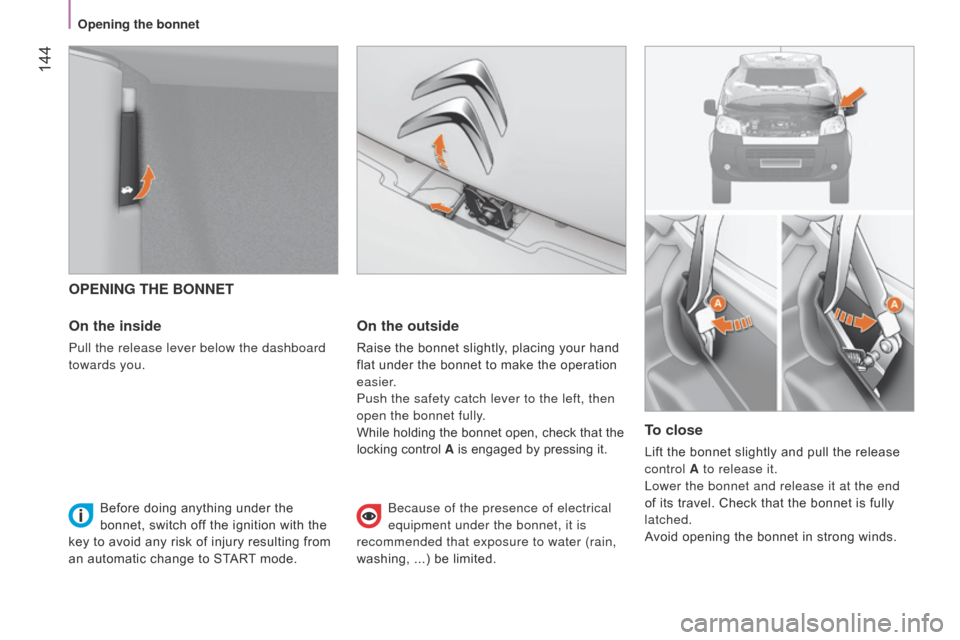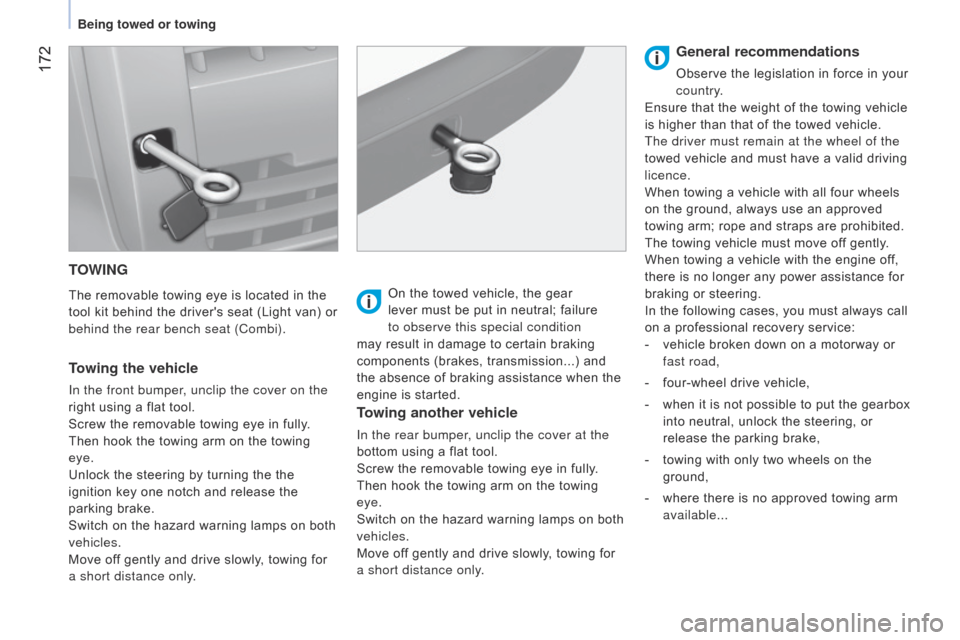key Citroen NEMO RHD 2015 1.G Owner's Guide
[x] Cancel search | Manufacturer: CITROEN, Model Year: 2015, Model line: NEMO RHD, Model: Citroen NEMO RHD 2015 1.GPages: 193, PDF Size: 8.3 MB
Page 145 of 193

143
Resetting
To set off again, restore the fuel supply and
the electrical supply manually:
-
with the key in the
STOP position, turn
the key to the RUNNING position,
-
push the direction indicator control stalk
fully upwards,
-
place it in the "Of
f" position,
-
press the direction indicator control stalk
fully downwards,
-
return it to the "Of
f" position,
-
push it fully upwards again,
-
return it to the "Of
f" position,
-
press it fully downwards again,
-
return it to the "Of
f" position,
-
turn the key to the
STOP position.
Fuel used for petrol engines
The petrol engines are compatible with
E10 bio-petrol (containing 10 % ethanol),
conforming to European standards EN 228
and EN 15376.
E85 type fuels (containing up to 85 %
ethanol) are reserved exclusively for
vehicles marketed for the use of this type
of fuel (b ioFlex vehicles). The quality of
the ethanol must comply with European
standard EN 15293.
Fuel used for Diesel engines
The Diesel engines are perfectly with
biofuels which conform to current and future
European standards (
d iesel fuel which
complies with standard EN 590 mixed
with a biofuel which complies with standard
EN 14214) available at the pumps
(containing up to 7 % Fatty Acid Methyl
Ester).
The B30 biofuel can be used in certain
Diesel engines; however, this use is subject
to strict application of the special servicing
conditions indicated in the maintenance and
warranty guide. Contact a CITROËN dealer
or a qualified workshop.
The use of any other type of (bio)fuel
(vegetable or animal oils, pure or diluted,
domestic fuel...) is strictly prohibited (risk of
damage to the engine and fuel system).
8
CHECKS
Fuel
Page 146 of 193

144
OPENING THE BONNET
On the inside
Pull the release lever below the dashboard
towards you.
On the outside
Raise the bonnet slightly, placing your hand
flat under the bonnet to make the operation
easier.
Push the safety catch lever to the left, then
open the bonnet fully.
While holding the bonnet open, check that the
locking control A is engaged by pressing it.
To close
Lift the bonnet slightly and pull the release
control A to release it.
Lower the bonnet and release it at the end
of its travel. Check that the bonnet is fully
latched.
Avoid opening the bonnet in strong winds.
Before doing anything under the
bonnet, switch off the ignition with the
key to avoid any risk of injury resulting from
an automatic change to START mode.
b
ecause of the presence of electrical
equipment under the bonnet, it is
recommended that exposure to water (rain,
washing, ...) be limited.
Opening the bonnet
Page 150 of 193

148
Engine coolant level
only use the fluid recommended by the
manufacturer . Otherwise, you risk seriously
damaging your engine. When the engine
is warm, the temperature of the coolant is
controlled by the engine cooling fan. As
this fan can operate with the ignition key
removed and because the cooling system is
pressurised, wait for at least one hour after
the engine has stopped before carrying out
any work.
Topping up
The level must be between the MIN and
MAX marks on the header tank. If more than
1 litre of fluid is required to top up the level,
have the system checked by a CITROËN
dealer or a qualified workshop.
Power steering fluid level
The vehicle must be parked on level ground
with the engine cold. Unscrew the cap with
integral gauge and check the level which
must be between the MIN and MAX marks.
Screenwash fluid level
For optimum cleaning and to avoid freezing,
topping up or replacement of this fluid
should never be with plain water; we
recommend the use of products available
from CITR
o Ë n dealers.
Capacity of the reservoir: approximately
3
litres.
Slacken the cap by two turns to release the
pressure to prevent any risk of scalding.
When the pressure has dropped, remove the
cap and top up the level with coolant.
If fluid has to be added frequently, this
indicates a fault which must be checked by a
CITROËN dealer or a qualified workshop as
soon as possible.
Used products
Avoid prolonged contact of used oil with the
skin.
Brake fluid is harmful to health and very
corrosive.
Do not dispose of used oil, brake fluid or
coolant into drains or into the ground, but
into the containers provided for this purpose
at CITR
o Ë n dealers (France) or at an
authorised waste disposal site.
Levels
Page 169 of 193

167
CHANGING A FUSE
The two fuseboxes are placed on the
dashboard on the driver's side and under the
bonnet.
Removing and fitting a fuse
Before changing a fuse, the cause of the
fault must be found and rectified. The fuse
numbers are indicated on the fusebox.
a
lways use the special tweezer to extract
the fuse from its housing and check the
condition of its filament.
Always replace a faulty fuse with a fuse
of the same rating.
If a fuse fails again soon after replacement,
have the electrical system of your vehicle
checked by a CITROËN dealer or a qualified
workshop. Access to fuses in the dashboard
-
T
o gain access to the dashboard fuses,
remove the 2 screws using the ignition
key and tilt the housing.
CITR
o
Ë
n
will not accept responsibility
for the cost incurred in repairing your
vehicle or for rectifying the malfunctions
resulting from the installation of accessories
not supplied and not recommended by
CITR
o
Ë
n
dealers and not installed in
accordance with its instructions, in particular
when the combined consumption of all of the
additional equipment connected exceeds
10 milliamperes. A.
Good.
B.
Failed.
C.
T
weezer.
Access to fuses in the engine compartment
-
For access to the fuses in the engine
compartment, remove the left hand front
headlamp connector, then unclip the
fusebox cover.
9
QUICK HELP
Changing a fuse
Page 174 of 193

172 172
TOWING
The removable towing eye is located in the
tool kit behind the driver's seat (Light van) or
behind the rear bench seat (Combi).
Towing the vehicle
In the front bumper, unclip the cover on the
right using a flat tool.
Screw the removable towing eye in fully.
Then hook the towing arm on the towing
eye.
Unlock the steering by turning the the
ignition key one notch and release the
parking brake.
Switch on the hazard warning lamps on both
vehicles.
Move off gently and drive slowly, towing for
a short distance only.On the towed vehicle, the gear
lever must be put in neutral; failure
to observe this special condition
may result in damage to certain braking
components (brakes, transmission...) and
the absence of braking assistance when the
engine is started.
Towing another vehicle
In the rear bumper, unclip the cover at the
bottom using a flat tool.
Screw the removable towing eye in fully.
Then hook the towing arm on the towing
eye.
Switch on the hazard warning lamps on both
vehicles.
Move off gently and drive slowly, towing for
a short distance only.
General recommendations
Observe the legislation in force in your
country.
Ensure that the weight of the towing vehicle
is higher than that of the towed vehicle.
The driver must remain at the wheel of the
towed vehicle and must have a valid driving
licence.
When towing a vehicle with all four wheels
on the ground, always use an approved
towing arm; rope and straps are prohibited.
The towing vehicle must move off gently.
When towing a vehicle with the engine off,
there is no longer any power assistance for
braking or steering.
In the following cases, you must always call
on a professional recovery service:
-
vehicle broken down on a motorway or
fast road,
-
four-wheel drive vehicle,
-
when it is not possible to put the gearbox
into neutral, unlock the steering, or
release the parking brake,
-
towing with only two wheels on the
ground,
-
where there is no approved towing arm
available...
Being towed or towing